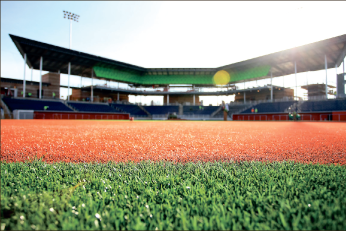Baseball is a sport that relies heavily on tradition. To a fan of America’s pastime like me, nothing compares to the nostalgic sights and smells of the ballpark, and the smell of freshly-cut grass is almost as essential to the game as the crack of a wooden bat.

Turf wars — Like it or not, Liberty baseball will be played almost entirely on artificial turf. Photo credit: Ruth Bibby
But anyone who has heard the sharp, metallic ping of a bat at a college baseball game knows that professional and collegiate baseball are two different ballgames.
After 34 years at Worthington Stadium, the Liberty Flames baseball team is set to play its first home game of the 2013 baseball season at the brand-new Liberty University Baseball Stadium Feb. 22, home of this year’s Big South Conference Championship Tournament. According to Liberty Athletic Director Jeff Barber, the new stadium will feature upgraded facilities across the board, including 2,500 chair-back seats, two suites, a club room, a 3,000 square-foot student patio with a fire pit and a playground for children.
“I think we’ll see a lot of jaws dropped from people walking into the stadium,” Barber said. “I just think it’s going to be so fantastic and beautiful that nobody really has an idea of how nice it is.”
Barber made it clear that the new stadium will be first-class, but there was one unconventional choice that puzzled me and other fans of Flames baseball. Instead of the traditional grass field with dirt basepaths, the new stadium will feature green and brown turf — making the pitcher’s mound the only real dirt on the entire field.
Although the trend in Major League Baseball has favored natural grass — there has not been a new stadium built featuring turf since 1990 — college baseball seems to be moving in the opposite direction. In a game where effort is sometimes measured by the amount of dirt on the uniform, artificial turf has begun to take over.
According to Barber, who readily admits his love for baseball tradition and natural grass, he considered other schools that have tried out Astro Turf’s product made specifically for baseball, and he liked what he saw. Virginia Tech, Wake Forest University, baseball powerhouse University of Texas and nearby James Madison University have all installed turf at their home field.
“We played Virginia Tech last year,” Barber said. “Before the game, I had one of the parents tell me that the (Liberty players) weren’t real crazy about the turf. So I went down there after the game and talked to them, and they had all changed their mind. Everybody I talked to said ‘Mr. Barber, we love this turf.’”
Major League Baseball allows more flexibility to play around bad weather due to its 162-game schedule, but for collegiate teams like the Flames who only played 60 games last year, every opportunity to pick up a win is crucial. According to Barber, turf can help alleviate those weather concerns, as well as allow for more preseason practice time and make field maintenance significantly easier and less expensive.
With four years of experience playing on natural grass at Worthington Stadium on his résumé, senior catcher Trey Wimmer said that he was apprehensive when he first heard about the decision to lay down turf.
“I kind of had mixed emotions because, personally, I love the traditional dirt, where you slide and get dirty,” Wimmer said. “But, at the same time, we’re going to have a lot fewer rainouts, a lot fewer delays (and) a lot less field maintenance, so it is a plus.”
Wimmer also said that the rubber-molded cleats that the Flames will wear during games will make it much easier to move around on the turf, as opposed to the usual metal cleats.
The Flames will also have to adjust to different types of bounces off the turf, but once they get acclimated to the new surface, they will have a considerable home-field advantage, according to Wimmer.
“I think it was the right decision, especially with the winters we’ve had here, with all the setbacks and the games we didn’t get to play in the spring,” Wimmer said. “In the long run, it will be the better choice than what we have now.”
As a former baseball player and an avid fan, a small part of me will still cringe when I see a baseball take a spring-loaded bounce off brown infield turf this coming season, but for the most part, my reservations have been resolved.
In my opinion, grass and dirt are part of what makes baseball tradition great, but, like many players in Liberty’s dugout, I will willingly accept a turf field if it means getting the chance to see the Flames play 10 more games each year.
Erie
March 7, 2023
As a baseball player, I understand the importance of turf grass in the game. When I step onto a field with turf grass, I feel like I’m playing on the best surface possible. It provides a consistent playing surface that is great for both defense and offense. It’s also easy to maintain and can handle a lot of wear and tear. It’s a great choice for baseball fields because it’s durable and can withstand a lot of traffic. The turf grass also helps to keep the field cooler in the summertime, which is great on hot days. I’m glad that so many baseball fields are choosing to use turf grass because it allows us to play our best every time.